Do you know what the tastiest traditional Korean dishes are? You might think of Korean BBQ, or maybe kimchi and ramyeon. These are just the tip of a culinary iceberg that covers a wide range of dining options for all travellers. Meet the 30 most mouth-watering traditional Korean dishes that you will be craving now and long after you return from your trip to Korea.
You can plumb the depths of an ocean of exquisite tastes, incredible eating experiences, and a variety of flavours, textures, smells, and sights while partaking in Korea’s finest traditional fare. The hardest part of visiting Korea is having to choose which ones to eat and when!
There’s something for everyone in this list, whether you’re a meat-lover, vegetarian, vegan, spice-lover, or seafood-addict. There often isn’t enough time to try them all, so take a look at the list below and see which ones you shouldn’t miss. I’ll share my favourites with you and tell you why they’re irresistible, too.
Affiliate Disclaimer: This site contains affiliate links and I may earn commission for purchases made after clicking these links.
Why Try Traditional Korean Dishes?
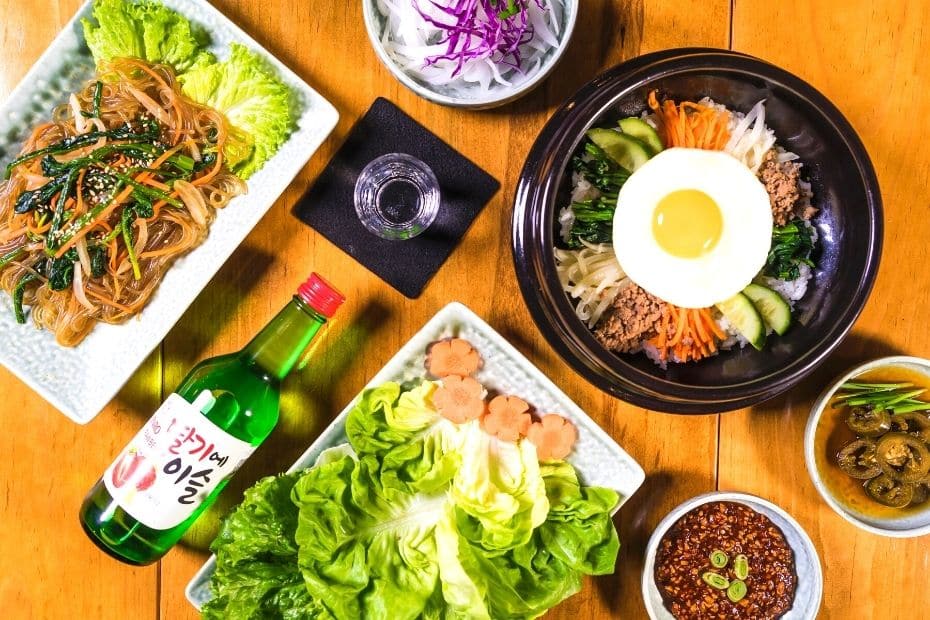
A meal in Korea is like a window into the local culture, where sharing food is core to a harmonious society, and meals are designed to be enjoyed by many people. This makes eating out a stomach-pleasing and soul-warming event that can be lots of fun and lead to some amazing nights out.
Eating traditional Korean meal can be a spectacle that’s best shared with friends or family. Korean meals come with an array of side dishes to sample, a large pot of something yummy boiling or frying in the centre of the table, and food lovingly prepared by chefs who specialise in this one dish.
If you’re eager to know more about Korean dining culture and want to know about what to do and how to behave, then make sure to keep reading till the end of this article. There are some Korean dining tips that will help you learn about the language, culture, and etiquette of eating out in Korea.
Note about prices: food prices have been rising sharply over the last few years and this has led to a rise in the cost of eating out. If you visited Korea in the past, don’t be surprised to see costs have risen 10% or more. Prices quoted are averages and don’t include extras such as drinks.
Now let’s begin this culinary journey. Make sure you’ve got something to nibble on while you read, as you’re going to feel hungry by the end of this!
The 5 Best Traditional Korean Dishes You Must Try
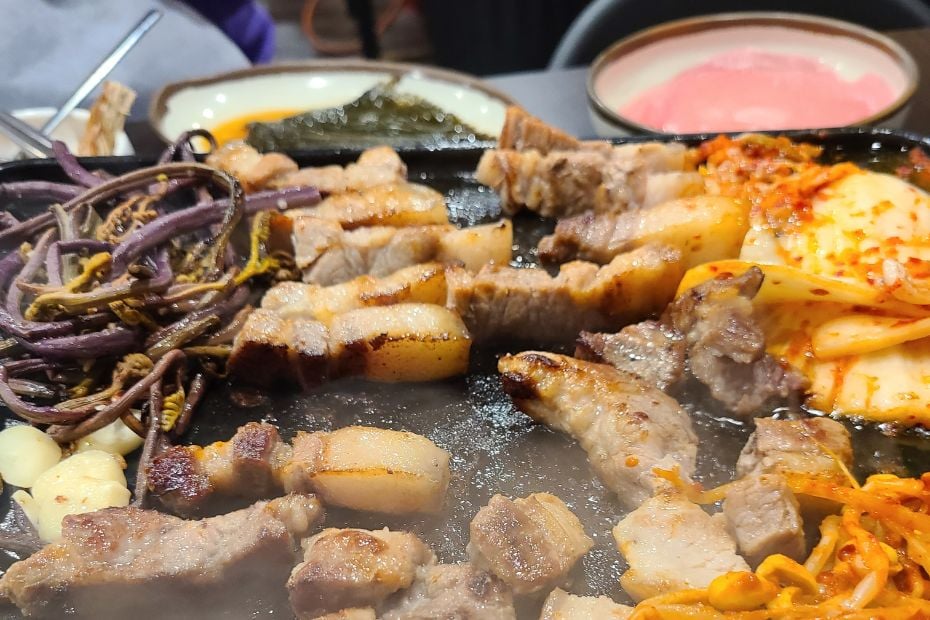
There are many incredible traditional Korean meals to try when you visit Korea, but which ones are the ones you simply can’t leave Korea without trying? If you’re only travelling to Seoul for a weekend or quick stopover, these 5 traditional Korean dishes should definitely be on your eating out itinerary!
1: Samgyeopsal – Korean BBQ
There are numerous options for BBQ in Korea, with different cuts of meat, but the definitive experience comes from eating samgyeopsal (literally – three layered pork). It’s thick, juicy, cheap, and you can find it everywhere. Most Korean BBQ restaurants will serve samgyeopsal as well as other cuts of meat and you buy them in 100g to 200g servings, which is usually enough for one person.
I have to admit, this is my favourite traditional Korean food. It’s different from a British or American BBQ, but certainly gives you the same fix and will leave you feeling stuffed. Instead of Western BBQ, which is usually served with bread rolls and buns, with Korean BBQ you instead wrap the meat in a slice of lettuce or similar veggie and add in extras such as a clove of garlic, onions, bean sprouts, and various sauces and salts.
Why you should try it: The iconic Korean meal that is more of a social event than a simple meal. Eat, drink, laugh, and end up in a meat coma with a smile on your face. BBQ meals aren’t cheap and you often spend more than you realise, but that’s because you’re having fun chatting and eating with a bottle of soju or two.
Cost: W15,000+
Korean: 삼겹살
Where to try in Seoul: 853 Korean BBQ
2: Kimchi Jjigae – Kimchi Stew
Kimchi jjigae is a delightful mix of cabbage kimchi, tofu, cellophane noodles, pork or tuna, and vegetables, served with a portion of rice. If you’re visiting Korea during the winter time, then any jjigae (stew) is the perfect way to recover from the cold, harsh winter weather.
When the kimchi is sautéed, it becomes softer and releases all its flavour into the stew, creating a hearty broth. You can even add more kimchi as it comes as a side dish, too. The best way to eat it is to put a bit of rice on your spoon, dip it in the broth, then top it with the other ingredients.
Why you should try it: There are so many reasons to try a steaming bowl of kimchi jjigae, especially if you’re visiting Korea during winter. This traditional Korean dish is packed with authentic Korean ingredients, including healthy kimchi.
Cost: W10,000+
Korean: 김치 찌개
Where to try in Seoul: Guldari Shikdang
3: Tteokbokki – Spicy Stir Fried Rice Cakes

Tteokbokki is a blend of steamed and sliced rice cakes (tteok 떡), fish cakes (odeng 오뎅), and scallions in a sweet and spicy sauce with plenty of chilli paste. If you’re eating in a restaurant, then add in some cheese and noodles for a filling meal. This is one of the traditional Korean dishes you shouldn’t pass up if you’re exploring traditional markets in Korea.
Best eaten fresh from the market vendors, this spicy, salty mishmash of classic Korean ingredients is perfect as a snack or meal. As you can tell from the red colour, it’s going to be spicy! Spiciness and the ingredients in the sauce can vary between vendors – everyone has their own secret recipe. Try it more than once and see which is the best.
Why you should try it: The perfect Korean winter food. Heart-warming and filling on a cold winter’s day. Cheap, delicious, and found in many places.
Cost: W10,000+ (Meal)
Korean: 떡볶이
Where to try in Seoul: Tteokbokki Town
4: Bibimbap – Mixed Rice With Vegetables
Literally meaning ‘mixed rice’, bibimbap is a fun, healthy jumble of vegetables, rice, chilli paste, and is topped off with a fried egg. Take all the ingredients and mash them together yourself. Add as much gochujang 고추장 (chilli paste) as you can handle and serve until everything is mixed together like a tossed salad.
Bibimbap is served either cold, in a metal bowl, or heated in a hot stone bowl (dolsot bibimbap 돌솥비빔밥). The hot version is the best version in my opinion as the egg and rice stick together and cook on the hot stone. If you’re visiting Jeonju, then make sure you try bibimbap there as they have their own version called Jeonju-bibimbap and it’s arguably one of the best.
Why you should try it: Another one of Korea’s national dishes. Popular in Korea and overseas. It’s a healthy mix of vegetables and spices that is perfect in winter or summer.
Cost: W10,000+
Korean: 비빔밥
Where to try in Seoul: Nongri Bapsang
5: Gimbap – Seaweed Wrapped Rolls
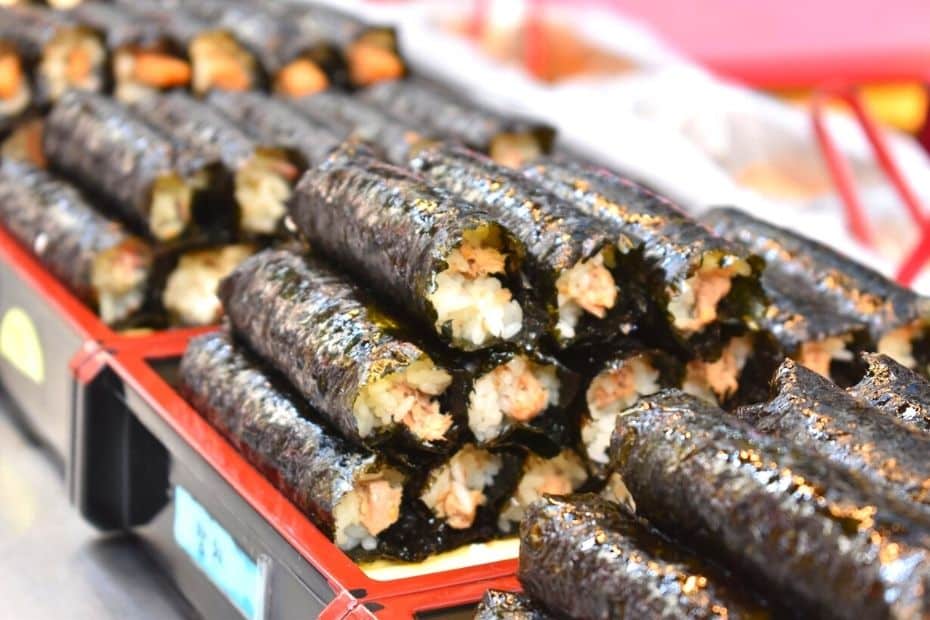
Gimbap (also spelt kimbap) is extremely versatile and can be bought as a snack from a convenience store, or the main part of a meal in a traditional Korean restaurant. This simple dish is actually one of the most popular traditional Korean dishes for students and people looking for a light, low priced lunch. The gimbap pictured above are the little roll gimbap (mayak gimbap – 마약김밥), but this dish is typically a larger roll sliced up like a California roll.
I personally love gimbap as it is light, healthy, and comes in a range of mouth-watering fillings, such as cream cheese, bulgogi (fried beef), lobster, and lots more. Typically I eat at least one gimbap a week as it’s perfect for lunch on the go. This is a great meal option for those who want to cut their costs while travelling to Korea. It’s also great when you want to go hiking and need to pack a filling snack for the journey.
Why you should try it: This Korean street food is a lot healthier than many of the other street eats you’ll find in Seoul. Gimbap has lots of great fillings, it’s so cheap, and so convenient.
Cost: W4,000+ (Meal)
Korean: 김밥
Where to try in Seoul: Yeonhee Gimbap
Planning to visit Korea? These travel essentials will help you plan your trip, get the best deals, and save you time and money before and during your Korean adventure.
Visas & K-ETA: Some travellers to Korea need a Tourist Visa, but most can travel with a Korean Electronic Travel Authorisation (K-ETA). Currently 22 Countries don’t need either one.
How To Stay Connected: Pre-order a Korean Sim Card or a WiFi Router to collect on-arrival at Incheon Airport (desks open 24-hours). Alternatively, download a Korean eSIM for you travels.
Where To Stay: For Seoul, I recommend Myeongdong (convenient), Hongdae (cool culture) or Gangnam (shopping). For Busan, Haeundae (Beach) or Seomyeon (Downtown).
Incheon Airport To Seoul: Take the Airport Express (AREX) to Seoul Station or a Limo Bus across Seoul. Book an Incheon Airport Private Transfer and relax to or from the airport.
Korean Tour Operators: Tour companies that have a big presence in Korea include Klook, Trazy, Viator, and Get Your Guide. These sites offer discounted entry tickets for top attractions.
Seoul City Passes: Visit Seoul’s top attractions for free with a Discover Seoul Pass or Go City Seoul Pass. These passes are great for families and couples visiting Seoul – you can save lots.
How To Get Around: For public transport, grab a T-Money Card. Save money on Korea’s high speed trains with a Korea Rail Pass. To see more of Korea, there are many Rental Car Options.
Travel Money: Use money exchanges near Myeongdong and Hongdae subway stations for the best exchange rates. Order a Wise Card or WOWPASS to pay by card across Korea.
Flights To Korea: I use flight comparison sites such as Expedia and Skyscanner to find the best flights to Korea from any country. Air Asia is a good option for budget flights from Asia.
How To Learn Korean: The language course from 90 Day Korean or Korean Class 101 both have well-structured lessons and lots of useful resources to help you learn Korean.
Top 12 Authentic Korean Meals With Meat
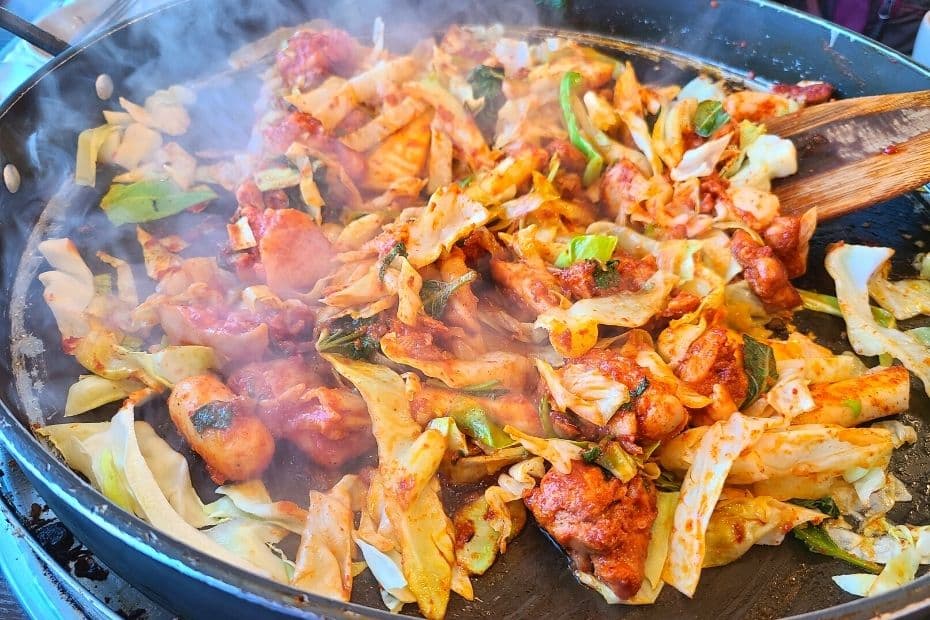
Meat-lovers visiting Korea will have no problems finding delicious and filling Korean traditional dishes. There are many Korean meals that come with meat, including dishes with beef, pork, chicken, duck, and lamb. These dishes often involve fried meats, but there are also steamed meats and stews, too.
1: Chuncheon Dakgalbi – Spicy Stir Fried Chicken
Chuncheon dakgalbi is another of those traditional Korean dishes for those people who love fried meat. This dish combines marinated chicken with vegetables, rice cake (tteok 떡 ), chilli paste sauce, and other spices. You can also add noodles and cheese.
These ingredients are chucked in a large pan and stir fried at your table. A waiter will come every few minutes and mix it all up for you. This makes it a great food to experience, not just eat. Although dakgalbi has spread throughout Korea, it first started in Chuncheon and this is the best place to try it. Visit Chuncheon Myeongdong Dakgalbi Street for the finest examples of one of Korea’s best traditional Korean dishes.
Why you should try it: A quintessentially Korean dish that mixes meat, vegetables, and spices together and fries them in a big metal pan. Add cheese for a greedy, satisfying meal.
Cost: W15,000+
Korean: 춘천 닭갈비
Where to try in Seoul: Chuncheon Dakgalbi
2: Samgyetang – Ginseng Chicken Soup
Samgyetang, a meal in a bowl, contains a whole small chicken packed with rice, garlic, jujube, and ginseng. The thick soup absorbs all of this whilst cooking, leaving a soft, tender chicken and an aromatic, hearty broth. Perfect! Ironically, this hot, healthy, and delicious ginseng chicken soup is most popular during summer.
Koreans have a saying that you should fight heat with heat, meaning that you should eat hot food when it’s hot outside. As strange as it sounds, it actually works. As with most traditional Korean dishes, you’ll find the best samgyetang in a traditional Korean restaurant. You can sit on the floor at a long table and indulge in the soup with a wide range of side dishes.
Why you should try it: This is a filling meal that is worth the cost. Perfect during winter, and (if you believe the stories) great Korean summer dish. Healthy and full of ingredients you might not find in your own country.
Cost: W15,000+
Korean: 삼계탕
Where to try in Seoul: JangAn Samgyetang
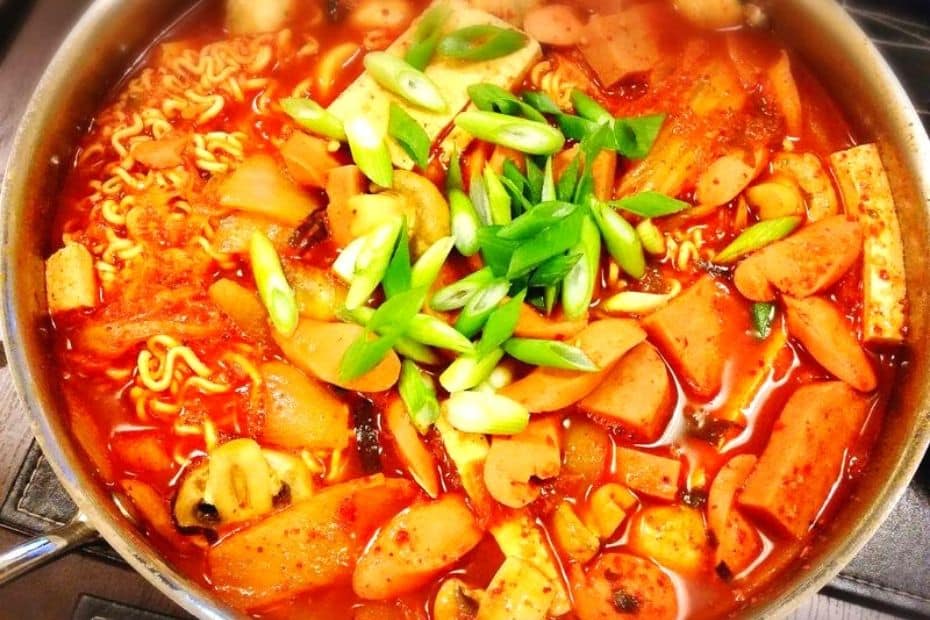
3: Budae Jjigae – Army Stew
Budae jjigae was created by adding various items from American army bases into a regular jjigae (stew). This included Spam, sausages, baked beans, American cheese, as well as some local items, such as instant noodles and tteok (rice cakes).
If you’re wondering how such an obviously foreign food item made it into a traditional Korean dish, the answer goes back to the Korean War. Meat was hard to come by then and the American soldiers provided the locals with food aid. This unique fusion of American and Korean foods created one of the best dishes in Korea to eat on a cold day. The bright red stew is packed full of rather unhealthy foods, which makes it taste great and gives you lots of energy!
Why you should try it: Great in cold weather and a guilty treat that’s not just for soldiers. A delicious mix of East and West.
Cost: W10,000+
Korean: 부대찌개
Where to try in Seoul: Heungbune Budae Jjigae
4: Sundae – Blood Sausage
One of the oldest traditional dishes in Korea, sundae might make people squeamish at first but it shouldn’t be missed. Sundae is kind of a cross between haggis and black pudding. It is also really delicious and a wonderful, cheap snack. Sundae traditionally contains pig or cow’s intestines mixed in with rice and vegetables and has long been a regular family meal in Korea.
After the Korean War, cellophane noodles were added inside to bulk it out, and it became a cheap street food, too. Eat sundae by dipping it into a bowl of salt or other seasoning. It goes well with a cold beer on a warm evening. There’s also a soup version with slices of sundae, green veg, and rice in a hearty broth.
Why you should try it: Because it’s unique and cheap. One for people who want to indulge in Korean dishes. Live like a student and have a lively meal with sundae and beer.
Cost: W8,000+ (Meal)
Korean: 순대
Where to try in Seoul: HongdaeSak Sundae
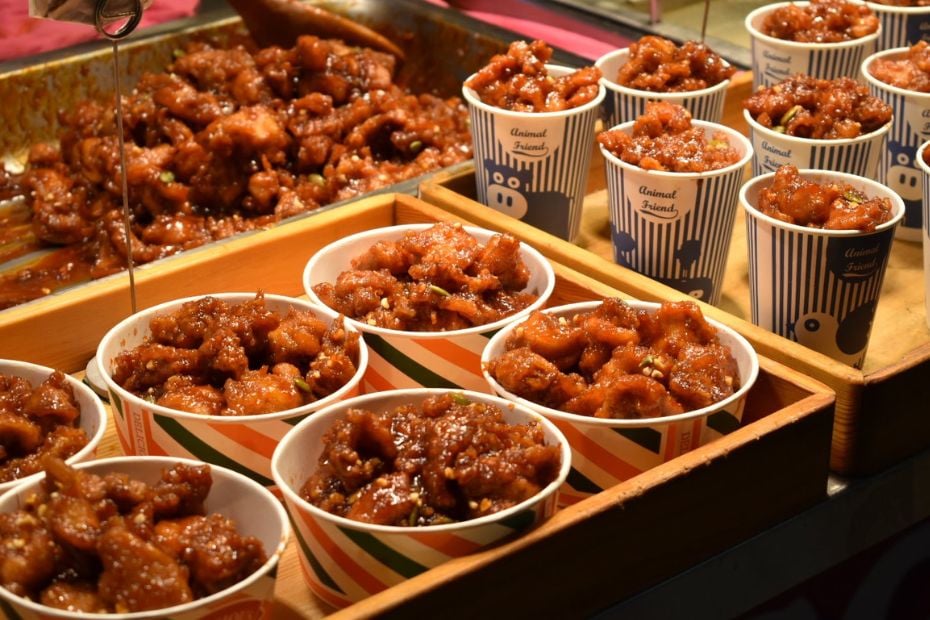
5: Yangnyeom Tongdak – Sticky Fried Chicken
Yangnyeom tongdak might not seem like the most authentic of all traditional Korean dishes, but its popularity means that it deserves a place on this list. With more than 20,000 fried chicken restaurants in Korea, this is definitely one of the national dishes.
Yangnyeom tongdak stands out above other flavours and types of chicken due to its finger licking qualities. This bold mix of sweet, sour, and spicy sauce lavishly spread over regular fried chicken just works. Topped off with crushed nuts, it’s irresistible. You can find this as a snack at a Korean baseball game, as a meal on its own, or anywhere selling Korean street food. Grab a cup of it and dip your fingers in if you don’t mind getting messy, or use some chopsticks if you do.
Why you should try it: The combo and chicken and beer is one enjoyed around the world, but few countries do it as well (and as reasonably priced) as Korea.
Cost: W15,000+
Korean: 양념 통닭
Where to try in Seoul: Bareun Chicken
6: Bossam – Wrapped Boiled Pork
A typical bossam meal comes with a big plate of sliced boiled pork, at least 3 types of kimchi, raw garlic, dipping sauces, and several different things to wrap all of that in. Koreans love to wrap their food in lettuce and cabbage and bossam takes this to another level.
This is a meal all about dipping and wrapping slices of boiled pork – which is more appetising than it sounds. It’s also healthier than fried alternatives. Choose your favourite ingredients, select one of the dipping sauces or salt, wrap them all up in a lettuce, cabbage, or sesame (perilla) leaf, and then eat in one go. The best part of this meal is experimenting with combinations of all of these separate options.
Why you should try it: As much fun as eating samgyeopsal, but less smoky and probably a bit healthier. This is also a great dish to enjoy whatever the weather.
Cost: W15,000+
Korean: 보쌈
Where to try in Seoul: Insadong Manul Bossam
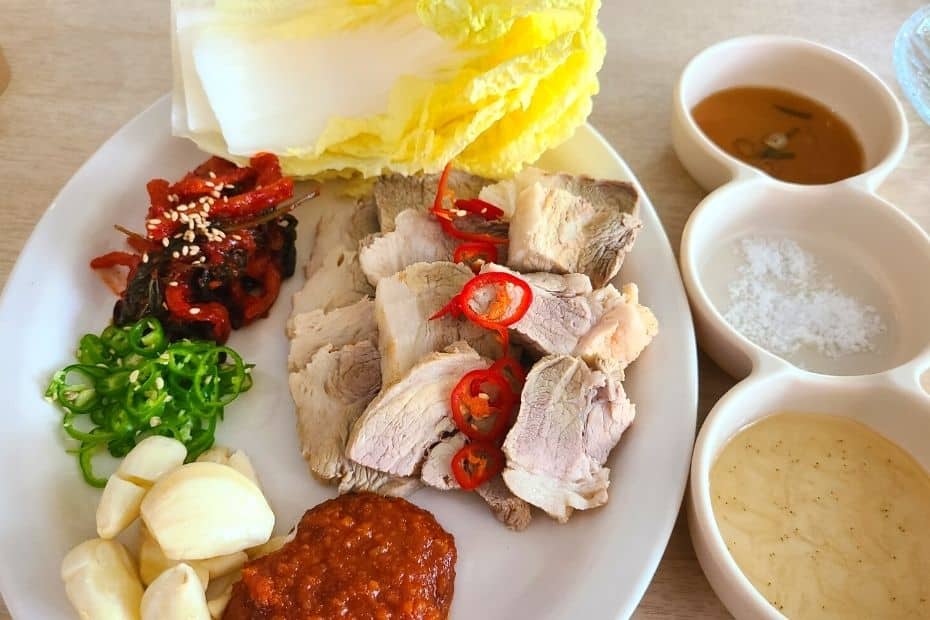
7: Bulgogi – Korean Grilled Beef
Bulgogi is one of the oldest traditional Korean dishes you can find. Literally translated as fire (bul 불) meat (gogi 고기), this dish is very adaptable and bulgogi can be found in many different meals. You will usually find it barbecued though.
Bulgogi usually comes with sliced beef, which is marinated and then grilled to give it a wonderful smoky, rich meaty taste. It can be other types of meat, too, including pork. Wrap the freshly cooked meat in a lettuce leaf (like samgyeopsal), add extras, and then shove it into your mouth in one go. This style of eating might seem strange to foreigners, but is completely normal to Koreans.
Why you should try it: A nice alternative to samgyeopsal, especially if you can’t eat pork. You’ll get all the same side dishes and have fun wrapping up the meat, but this time it’s thin slices of beef.
Cost: W15,000+
Korean: 불고기
Where to try in Seoul: WooRae-Ok Bulgogi
8: Byeo Haejangguk – Bone Hangover Soup
There are many types of haejangguk (hangover soup) in Korea that are eaten late at night or in the early morning to cure headaches, but the best of them is byeo haejangguk. This version comes with meat-clad bones, a thick broth, and lots of seasoning. The meat falls off the bone easily as you mix together meat, soup, rice, and side dish and send it down to your awaiting insides, ready to be embraced and to start repairing your body after a night of drinking.
Of course, you don’t have to eat this only when you have a hangover. It’s great any time, especially in winter. A hot bowl of this with a cool beer, and lots of side dishes is the perfect way to get through a cold January night.
Why you should try it: This dish is perfect on a cold day and will revive and restore you when you’re not feeling well. Fills your belly and your soul.
Cost: W8,000+
Korean: 뼈 해장국
Where to try in Seoul: Sindong Gamjatang
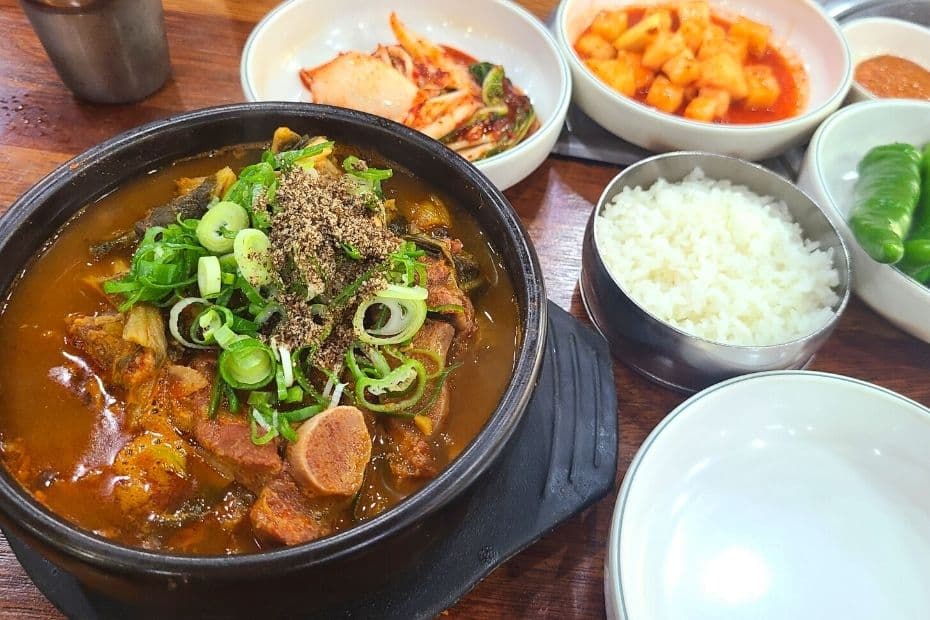
9: Galbi-Gui – Grilled Ribs
Galbi-gui is a type of grilled dish that is made with marinated pork or beef short ribs in a ganjang-based sauce (Korean soy sauce). In Korean, galbi (or kalbi) literally means “rib” and can often indicate uncooked ribs. Unlike ribs in the USA, these are often served in long strips of meat that you’ll need to cut into smaller sections yourself.
As galbi-gui is typically served raw, you get to cook the seasoned ribs on a tabletop grill in the centre of the table. This makes it not only a delicious culinary experience, but also a fun one where you’re in charge of cooking the meal. Don’t worry, staff will help if you’re in trouble.
Why you should try it: These finger-licking ribs are really hard to eat with chopsticks, but worth the effort. The meat is juicy and tender.
Cost: W15,000+
Korean: 갈비구이
Where to try in Seoul: Hangaram Bonjeom
10: Kimchi Bokkeumbap – Kimchi Fried Rice
Kimchi bokkeumbap is a humble Korean dish made basically with kimchi, leftover rice, and whatever else you might have to hand. You’ll find kimchi bokkeumbap served as a meal with spam and spring onions added, as well as a fried egg served on top. The best way to enjoy kimchi bokkeumbap is after a Korean BBQ. Add kimchi and rice to the BBQ hot plate, mix in any leftover meat, and fry it in the oil left on the pan. Perfect!
Since Korean homes almost always have rice and kimchi available, kimchi fried rice is a favourite go-to meal whenever there seems to be nothing to eat at home. This traditional Korean dish is especially popular among young people who are living on a low budget as it is a quick-fix meal, inexpensive to prepare, yet delicious and filling.
Why you should try it: If you want to experience a traditional Korean packed lunch, called dosirak, then order a meal of kimchi bokkeumbap. Old school Korean restaurants will serve it in the metal lunch boxes kids carried to school.
Cost: W8,000+
Korean: 김치볶음밥
Where to try in Seoul: Ajossi-ne
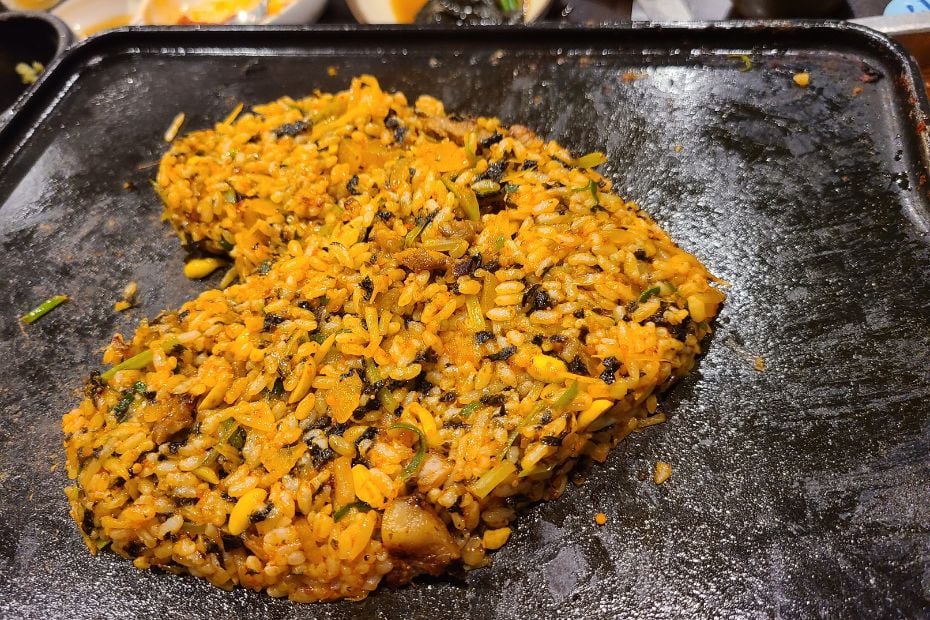
11: Yukgaejang – Spicy Korean Soup
Yukgaejang is a spicy Korean soup consisting of shredded beef (usually brisket), scallions, gosari (eagle fern), bean sprouts, leeks, or mushrooms. The soup is seasoned with chili paste, which gives it its distinctive bright red colour, as well as soy sauce, sesame oil, garlic, and chili flakes.
Yukgaejang is best served piping hot, with a bowl of rice on the side and generous helpings of kimchi to go with it. As it’s both hot and spicy, this dish is best eaten in winter when you need to warm yourself up or clear your sinuses (make sure you’ve got tissues available when eating this). There is a ‘white’ version that’s not so spicy, too.
Why you should try it: This is a simple yet filling meal that is cheap and quick. There are many yukgaejang places around so it’s easy to find.
Cost: W8,000+
Korean: 육개장
Where to try in Seoul: Jongnogob Yukgaejang
12: Seolleongtang – Ox Bone Soup
Seolleongtang or ox bone soup is a Korean broth made from ox bones (mostly leg bones), brisket and other cuts. A bowl of seolleongtang is served as-is and if you want to change the flavour, you can do so with the condiments at the table. However, I recommend trying it as-served as the chefs at these restaurants have one job and that’s to make the best broth every time.
This dish is traditionally served in the bowl it was cooked in, boiling hot and with a fried egg on top with white rice on the side. Be careful when it arrives, but don’t wait too long to start tucking in, just blow on the spoon a few times and you should be safe to munch away.
Why you should try it: A simple, lighter Korean meal than some of the other traditional dishes listed here. If you’re feeling tired of heavy food, try a bowl of seolleongtang.
Cost: W8,000+
Korean: 설렁탕
Where to try in Seoul: Singawon
Make Traditional Korean Dishes In Seoul
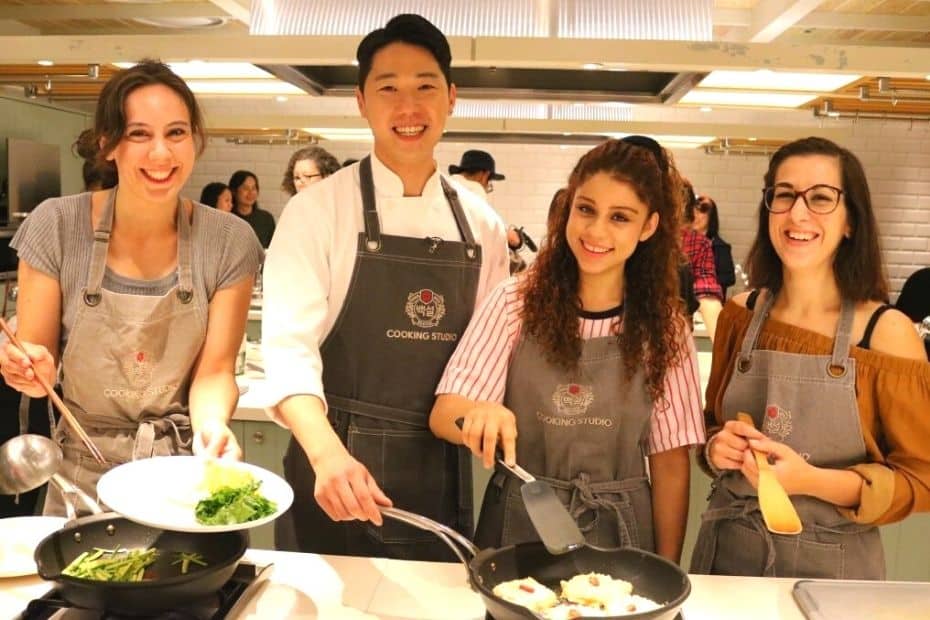
Want to try making your own traditional Korean dishes? There are loads of great opportunities to experience cooking traditional Korean food in Seoul. Why not try your hand at making some of these delicious traditional Korean dishes and create some fun memories on your travels?
Top 8 Korean Dishes With Vegetables & Noodles

These popular Korean dishes are great options for vegetarians or those looking to enjoy (mostly) meat-free noodle dishes, which are perfect in all seasons. Discover the healthy side of Korean cuisine that uses local ingredients and traditional techniques to create satisfying savoury meals you’ll love.
1: Naengmyeon – Ice-Cold Noodles
Naengmyeon is simple dish of cold buckwheat noodles. There are two main varieties – mul naengmyeon 물냉면 (ice-water cold noodles) and bibim naengmyeon 비빔냉면 (spicy cold noodles), both of which are perfect for summer. I prefer the mul naengmyeon (pictured) as the noodles are drowned in icy-cold water and become so refreshing. It’s topped with thin pieces of radish, cucumbers, and a boiled egg and seasoned with vinegar and mustard.
Bibim naengymeon is mostly the same but instead of icy-cold water, the noodles are splashed with spicy chilli paste and form a deadly bowl of spicy noodles. This dish can be deceptively spicy, so be careful. I find that mul naengmyeon is perfect in winter while the bibim naengmyeon is suitable for any time of year.
Why you should try it: It might not look like much, but it is as refreshing as an ice cream on a hot summer’s day. The cold noodles give you back lost energy during the heat.
Cost: W8,000+
Korean: 냉면
Where to try in Seoul: Gom Naengmyeon
2: Kalguksu – Knife-Cut Noodle Soup
Literally meaning knife-cut noodle soup, kalguksu has chunky noodles because they are cut by hand and not spun, giving the noodles a rich taste. Extra ingredients can include shellfish, ground beef, chicken, some vegetables, or cilantro. Perfect during winter in Korea, this hot, steaming broth is simple but can refresh any weary traveller. It is also deceptively filling and hard to finish.
You can find freshly-cut noodles in Korea’s traditional markets. Watching chefs hack up noodles, throw them violently into the broth, and serve them directly to you, fresh and spongy, is a culinary experience in itself. Not only are the noodles some of the best you’ll find, but the broth in some kalguksu restaurants is perfected after decades of experimentation, where they only serve this one dish and have mastered it and made it as good as any meal can be.
Why you should try it: Very filling. The broth is thick and the noodles are thicker. If you find a kalguksu place with a lot of people in it, don’t miss the chance to try it.
Cost: W8,000+
Korean: 칼국수
Where to try in Seoul: Sarangbang Kalguksu
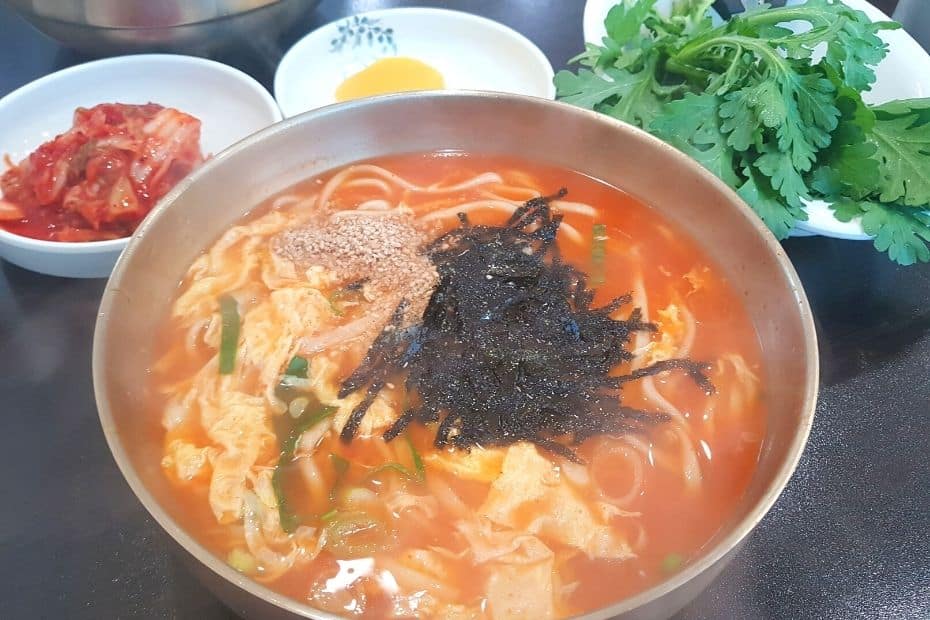
3: Manduguk – Dumpling Soup
Korean dumplings (mandu 만두) are best when they’re in their own soup – manduguk. Manduguk comes in a small or large bowl full of various mandu and squeezed in with tteok 떡 (rice cakes), sliced vegetables, ground meat, or egg. The mandu come with a variety of different fillings, including kimchi, meat, shrimp, and vegetables.
You usually get kimchi or meat dumplings in a manduguk, but good restaurants will have a range of options. As with some other traditional Korean dishes, there is a special day that people eat manduguk, and that is New Year’s Day. Start the New Year with a bowl of manduguk if you’re in South Korea. Families work together to make the dumplings by hand.
Why you should try it: Chew and munch on this hot dish during winter, trying each of the different types of mandu to find your favourite.
Cost: W10,000+
Korean: 만두국
Where to try in Seoul: Bukchonson Mandu
4: Japchae – Stir-Fried Glass Noodles
Japchae is a classic Korean dish that translates to ‘mixed vegetables’. This simple dish is a savoury and sweet combination of ingredients such as stir-fried glass noodles, mushrooms, spinach, carrots, chilli and bell peppers, garlic chives, and more. The main star of this dish is the glass noodles.
Japchae is a must-try for its unique texture and flavour. It’s really easy to eat as the ingredients are all soft and tender and it accompanies greasier (fried) foods well. Japchae is often served as a side dish during Korean holidays or special occasions and if you ever go to a Korean house, they’ll probably have a big tub of it in the fridge ready to dollop onto your plate.
Why you should try it: A healthy, simple meal that goes best as part of a big meal with a selection of other dishes to try. If you try a Korean royal-court dinner spread, expect to find this.
Cost: W8,000+
Korean: 잡채
Where to try in Seoul: Hanyang Jungshik
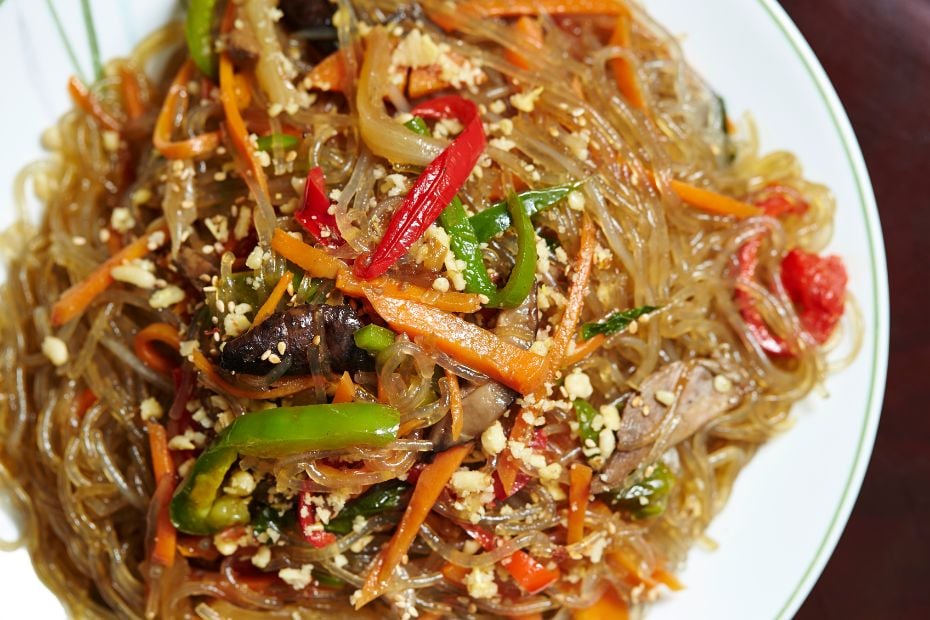
5: Sundubu-Jjigae – Spicy Soft-Tofu Stew
Sundubu-jjigae is a variety of traditional Korean stews. Besides numerous other ingredients, the foundation of sundubu is uncurdled tofu. Since the tofu is not strained, its consistency is not firm, but rather soft and silky, making it melt into the rest of the dish and provide a soft bite of deliciousness.
A bowl of sundubu-jjigae can be vegetarian-friendly, but can also include meat (usually beef) or a variety of seafood (or even both together). The main ingredients are a healthy mix of onions, zucchini, scallions, mushrooms, and garlic, which are all softened up in the hot spicy broth. Remember to dip some rice in, too.
Why you should try it: This truly traditional Korean meal is great when you’re feeling down and need a healthy pick-me-up.
Cost: W8,000+
Korean: 순두부찌개
Where to try in Seoul: Jeongwon Sundubu
6: Juk – Korean Rice Porridge
Juk is a Korean savoury rice porridge made with various ingredients, such as pumpkin, abalone, chicken, or mushrooms. Each version of juk typically comes with just one of these extra ingredients to add a twist of flavour.
This is a really popular meal for people who are feeling sick and if you eat out in a traditional Korean juk restaurant, you’ll probably hear some people sniffing away while wating for their healing bowl of porridge. Modern Koreans have adapted to the idea of having this healthy porridge as breakfast, light meal or as a comfort food, too.
Why you should try it: A bowl of juk during winter, or any time when you’re suffering, will really give you your energy back. And unlike medicine, this tastes really great!
Cost: W10,000+
Korean: 죽
Where to try in Seoul: Bon Juk
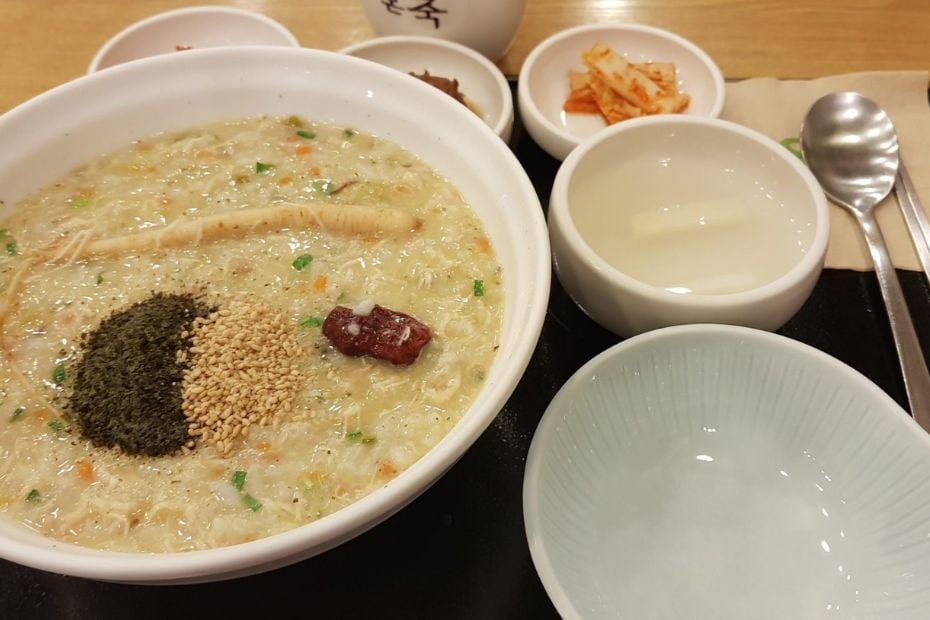
7: Jjajangmyeon – Noodles In Black Bean Sauce
Jjajangmyeon is a Korean-Chinese noodle dish topped with a thick sauce made of chunjang paste, diced pork, and vegetables. Although this dish contains meat (or sometimes seafood), the strength of the black bean sauce dominates the taste of this meal, as well as the colour! If you go to Incheon, make sure to try jjajangmyeon as this is the home of this popular Korean dish.
This black noodle dish is one of the most popular student foods or cheap eats in Korea and is often mentioned in K-dramas. There’s even a special day when people in Korea eat jjajangmyeon called Black Day (because of the colour of the sauce) – a kind of anti-Valentine’s Day when single people get to enjoy going out for a meal.
Why you should try it: If you want to experience life as a Korean student, eating a bowl of cheap jjajangmyeon is the best place to start. It’s a popular student dish due to its low price.
Cost: W6,000+
Korean: 짜장면
Where to try in Seoul: Gawon
8: Doenjang-Jjigae – Fermented Soybean Stew
Doenjang-jjigae is a staple Korean stew made with doenjang (된장), a fermented soybean paste, which gives it a strong taste and smell. It’s cheap and easy to make doenjang-jjigae, which is why you’ll find it served (often for free) with larger shared traditional Korean meals.
This hearty stew is often eaten regularly regardless of occasion or time of day. Depending on the other ingredients added, you can make endless variations of the stew. The large number of vegetables in doenjang-jjigae make it quite healthy, but if you’re looking for a vegetarian dish, this usually isn’t one as it contains pork, too.
Why you should try it: This rich, thick stew has a hearty broth and lots of vegetables inside. It often comes as a free extra with sharing meals but is worth trying by itself.
Cost: W8,000+
Korean: 된장찌개
Where to try in Seoul: Moonsuk-iminari
Vegetarian and vegan travellers to Seoul and Korea don’t need to worry as there are an increasing number of vegetarian-friendly restaurants and vegan-friendly restaurants in Seoul. There are plenty of traditional Korean dishes, including Korean temple cuisine, which are naturally vegan-friendly, too.
Top 5 Classic Korean Dishes With Fish & Seafood
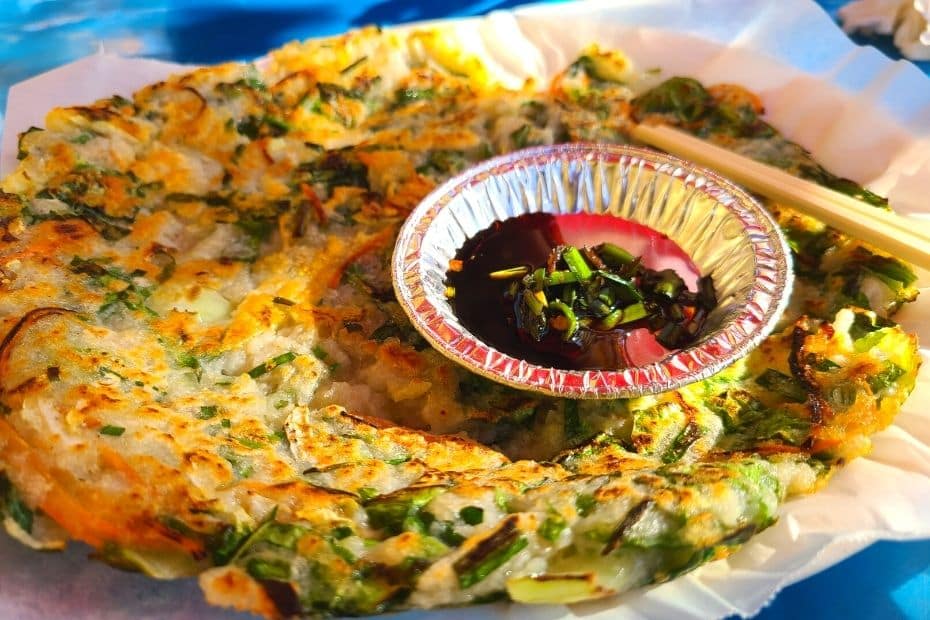
Korea is a peninsula surrounded by coasts on three sides with a bounty of fresh fish and seafood. There are many Korean dishes with fish and seafood prepared in a variety of forms, including raw, smoked, grilled, baked, and even fermented. Head to coastal cities such as Busan for these dishes.
1: Jeon – Korean Savoury Pancake
Jeon (Korean savoury pancakes) come with a variety of fillings, including kimchi, squid, potato, beef, pork, and more. The most popular of these is haemul pajeon 해물 파전 (squid and spring onions) and is a great treat when you’re tired and hungry.
If you’re hiking in Korea, you’ll find a lot of restaurants selling jeon. You’ll know them by the chefs frying them on a hot plate outside the restaurant. They’re served fresh to hungry hikers who are craving something filling after a long trek. Dip the jeon in spicy soy sauce and wash it down with another mountain-based speciality – makgeolli (막걸리). Makgeolli is a creamy rice wine that comes in some interesting flavours, such as chestnut, corn, and even banana.
Why you should try it: Embrace Korean culture when you’re out hiking in a national park by ordering a plate of jeon and makgeolli. Perfect after a long day of hiking or sightseeing.
Cost: W18,000+
Korean: 전
Where to try in Seoul: Jeondae Gamdaek
2: Maeuntang – Spicy Fish Stew
Maeuntang is a hot, spicy fish stew made with a range of different fresh fish. How do you know that the fish are fresh? You can usually choose the fish you want to eat from an aquarium outside the restaurant. The fresh fish are cut up and boiled with an assortment of vegetables and a bit of ground beef.
To give this dish its signature spiciness, generous helpings of red chilli paste (gochujang 고추장) and red chilli flakes (gochugaru 고추가루) are added. You can find lots of extras in a bowl of maeuntang, such as shellfish, garlic, and more. They give it an unforgettable taste and help make this one of Korea’s most beloved seafood dishes. A traditional Korean dish for those who love their food with a kick.
Why you should try it: Spice-lovers who want a dish without meat will be pleased with this. Full of fresh ingredients, tastes, and pretty healthy, too. A great combination.
Cost: W10,000+
Korean: 매운탕
Where to try in Seoul: Donggang-Naruto
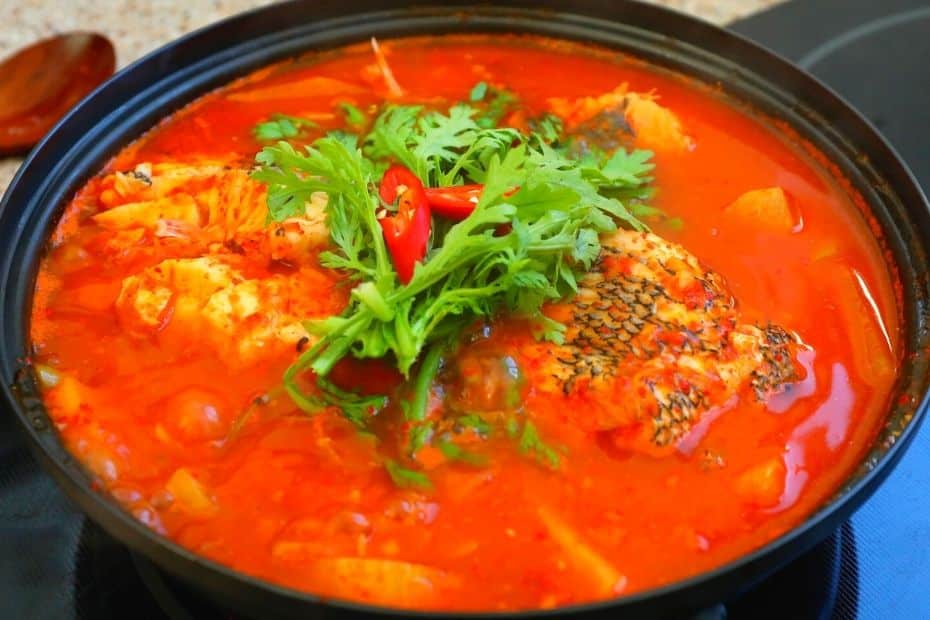
3: Hoe – Sliced Raw Fish
Hoe is one of the best traditional Korean dishes to eat if you’re visiting Busan or any other seaside town or city. This is more than what you’d expect from Japanese sashimi, hoe has other options beyond the normal thin slices of fresh fish. You’ll also find a medley of colourful, and sometimes more alive than expected, types of seafood and shellfish. Additional side dishes could include more seafood, kimchi, garlic, soup, soft crabs, fried fish, and more.
Dip the gentle slices in soy sauce and wasabi and indulge as is, or grab some lettuce or cabbage to wrap the raw fish in. Take a lettuce leaf and place the fish inside, along with some garlic and whatever else you like. Like a Korean BBQ but with seafood.
Why you should try it: You’ll find lots of essential nutrients in this juicy traditional Korean dish. If you’re by the coast, then you shouldn’t miss out on some of the seafood caught fresh from the seas surrounding Korea.
Cost: W20,000+
Korean: 회
Where to try in Seoul: Insaeng-Hoetjib
4: Ojingeo Bokkeum – Spicy Stir Fried Squid
I didn’t expect to like ojingeo bokkeum when I first tried it as I’m not a massive fan of squid. However, the soft, tender texture of the squid in this meal makes it surprisingly delectable and it has more of a meaty taste to it than you’d normally associate with seafood. You should definitely add it to your list whether you like squid or not.
The sweet, spicy sauce adds a lot to the taste of squid and goes well with the vegetables, too. Stir frying the lot together leaves a fresh, crisp, sweet, spicy, and not too fishy dish that you’ll want more and more of. Be careful if you’re not too keen on traditional Korean dishes that pack a spicy punch as this might make your eyes water.
Why you should try it: This is one of the most popular traditional Korean dishes and Koreans eat this at home or out. Easy to make, served quick and fresh.
Cost: W10,000+
Korean: 오징어볶음
Where to try in Seoul: Deoksujeong
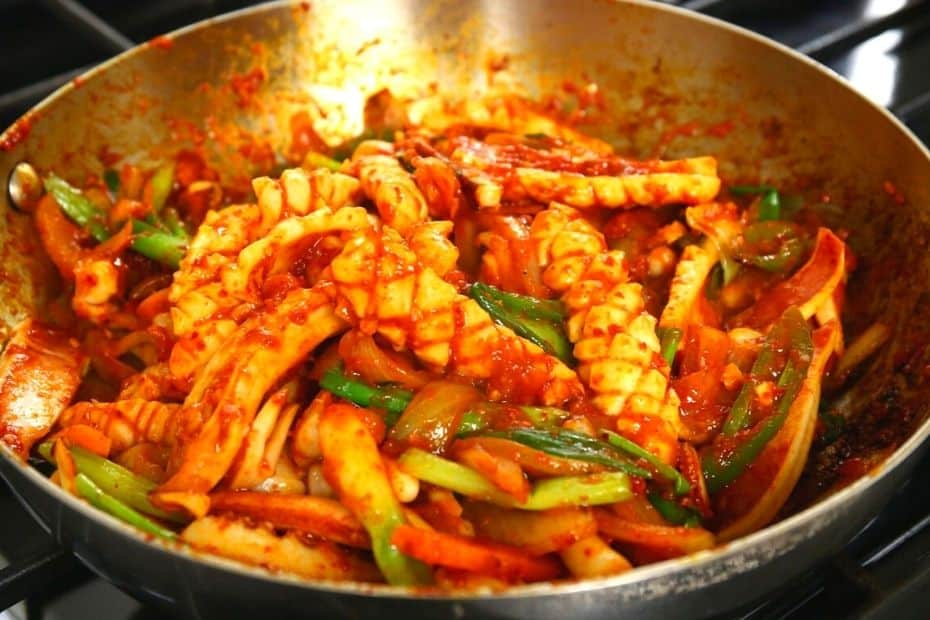
5: Godeungeo-Gui – Grilled Mackerel
Godeungeo-gui is one of the most popular and beloved fish dishes in Korea and one that you’ll often find served in canteens or for school lunch. This authentic dish features grilled mackerel that is generously seasoned with salt and lemon juice and cooked over a charcoal or gas fire until the skin is crispy and the flesh is moist and flaky.
The best thing about godeungeo-gui is that it’s a simple but satisfying dish that showcases the fresh and oily flavour of the fish, which is rich in omega-3 fatty acids and protein. This traditional fish meal is usually served with rice, soup, and various side dishes, such as kimchi, radish salad, soybean sprouts, and seaweed. If you want to try the best godeungeo-gui, eat it during autumn in Korea when mackerel are in season and have more fat.
Why you should try it: A crispy, healthy fish dish that will leave you licking your lips. If you’re visiting Korea in October, it’s a must-have dish.
Cost: W10,000+
Korean: 고등어 구이
Where to try in Seoul: Jeonju Shikdang
Bonus: Kimchi (Fermented Vegetables)
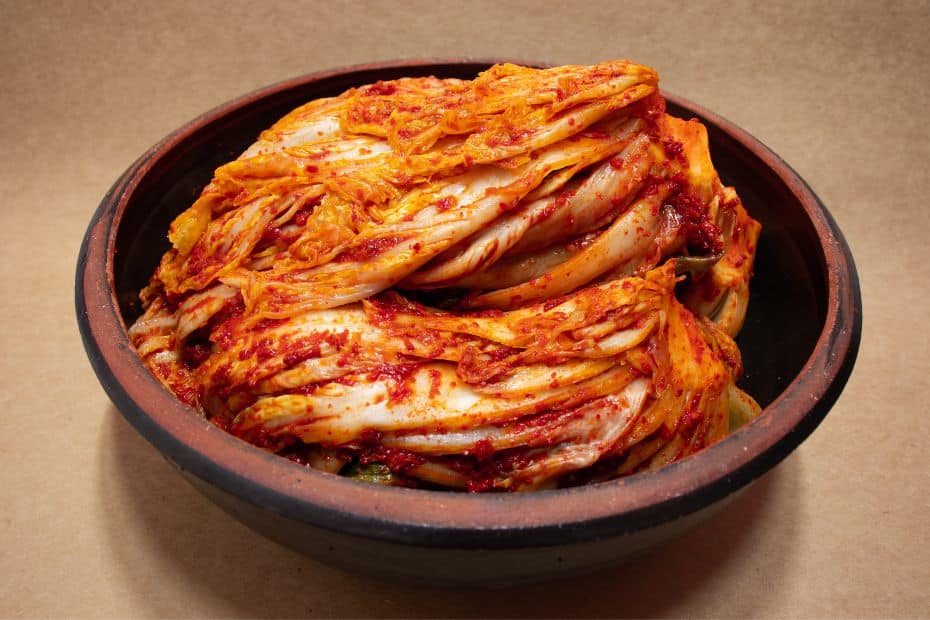
Of course, no list of traditional Korean dishes would be complete without mentioning kimchi. Although this isn’t a dish in itself, you probably won’t eat any of these dishes without it. There is nothing as ubiquitous as kimchi in Korean cuisine and it’s served with every meal of the day (even breakfast!). Korean’s even have a whole day of making kimchi each year called gimjang, which I’ve tried and it’s a lot of fun, but hard work.
Kimchi makes a great side dish to snack on, goes great in a stew, fits nicely in a wrap with BBQ or boiled meat, and even belongs in a taco. Koreans also believe that it has miraculous health benefits, including reducing cholesterol and stopping stomach cancer. It can even keep you young! Whether or not these all work, you certainly can’t travel to Korea without trying kimchi.
Why you should try it: It’s Korea’s national side dish, healthy, and goes so well with many of Korea’s best traditional dishes. I don’t think you’ll be able to visit Korea without sampling kimchi, which you definitely should.
Cost: Free with most meals
Korean: 김치
Where to try in Seoul: Everywhere
Make Traditional Korean Dishes At Home
Want to try making these traditional Korean dishes at home but not sure where to start? Here are some Korean cookbooks to teach you how to make a range of tasty Korean treats. Start with the basics, such as tteokbokki and mandu, or jump straight into filling meals like kimchi jjigae and jjajangmyeon.
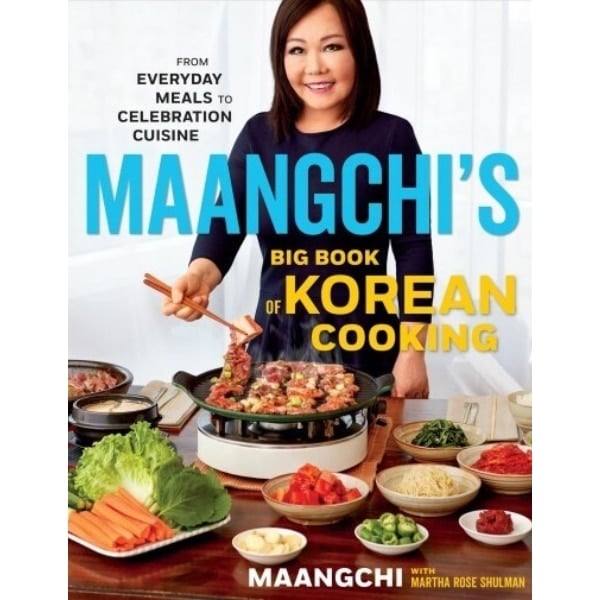
Maangchi’s Big Book Of Korean Cooking
The book contains the favourite dishes by famous Korean chef and YouTuber, Maangchi. She has perfected many Korean meals over the years, from Korean barbecue and fried chicken to bulgogi and bibimbap. Discover Maangchi’s professional approach to Korean cooking today.

The Korean Vegan: Joanne Lee Molinaro
Joanne Lee Molinaro has captivated millions of fans with her powerfully moving personal tales of love, family, and food. In her debut cookbook, she shares a collection of her favorite Korean dishes, some traditional and some reimagined, as well as poignant narrative snapshots that have shaped her family history.
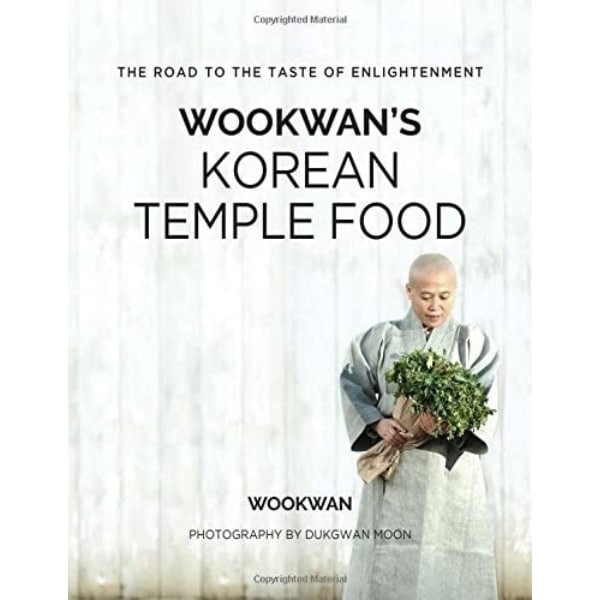
Wookwan’s Korean Temple Food
As the first volume of temple cuisine published in English, Wookwan herself has written an elegant volume that introduces the reader to Korean temple food, including what it means to care for the ingredients at each step of preparation, following the three key principles of cooking temple food, interspersed with her own accounts and tips among the recipes.
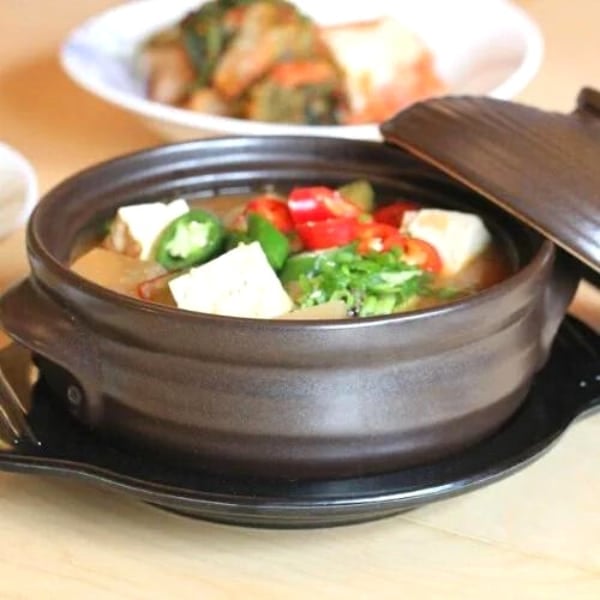
Korean Stone Bowl Cooking Pot
An essential part of many Korean winter dishes is the stone bowl (dolsot) cooking pot. This can be used to make dishes such as dolsot bibimbap, kimchi jjigae, and many other hot soups and stews.
Cookbooks not your thing? Check out the Baek Jong Won YouTube channel. He’s one of Korea’s most famous chefs and you can find his restaurants all over the place. He can teach you to make tteokbokki and many other tasty Korean winter foods.
Tips For Enjoying These Real Korean Dishes
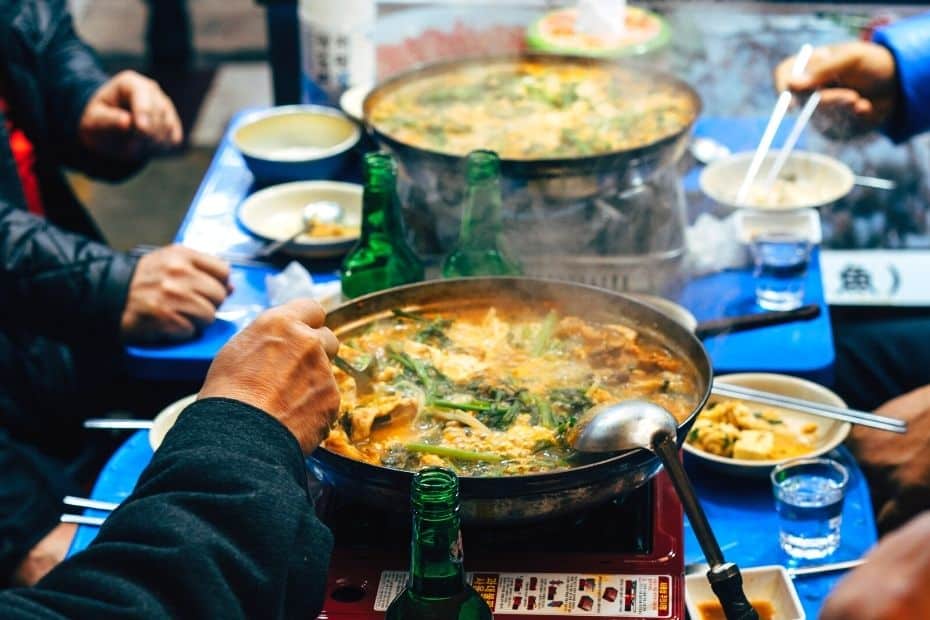
I’ve eaten out in Korea way too much, it’s hard not to. The food is cheap, delicious, and there is so much variety, a lot more than people realise before visiting Korea. I’ve put together a few tips to help you get even more out of your trip and the delicious Korean meals you’re going to enjoy.
1: Korean Food Is Cheap
Don’t be surprised by how much you get. However, food can get expensive, especially if you want to eat foreign foods. You’re in Korea and so I’d really recommend trying the local foods before looking for something more familiar.
2: Meals For Two
Some meals will be for two or more people and will be indicated on the menu with – 2인 (2 people in Korean). If you see this, then the price is for the whole meal, not per person. This is a big sharing meal and are often much better than individual meals – check them out!
3: Understanding Chinese Characters
Sharing meals (like those found in tip 2) usually come in 3 different sizes, which are represented by traditional Chinese characters. These are as follows:
- 小 (so) – small portion
- 中 (jung) – medium portion
- 大 (dae) – large portion
A small portion is enough for 2-3 people. Remember, the meal will usually come with side dishes, too. If you want to know more useful Korean, check out this article about phrases for eating-out in Korea.
4: Eat At The Markets
Korea’s traditional markets and street food stalls offer some of the most amazing traditional food and are often cheaper and fresher than in a restaurant. Be sure not to miss them when you visit Seoul and other cities as they are also a great place to pick up cheap souvenirs and interact with locals.
5: Indulge In Side Dishes
Traditional meals typically come with Korean side dishes, called banchan (반찬). These are included with the meal and if you ask for more, you can often get free refills. Don’t be surprised if you order a simple meal and end up with 10 or even 20 side dishes!
6: Wrap It Up
If your meal comes with a bowl of lettuce leaves (or cabbage), you’re probably meant to use it to wrap the other parts of the meal. Eating a Korean BBQ is a really fun experience and one of the times it’s ok to get your fingers dirty. Pick up some meat, garlic, kimchi, and whatever else you fancy, and wrap it inside the lettuce leaf and pop it into your mouth.
7: Stay Hydrated
Restaurants in Korea always give you free water (sometimes iced tea). This is a great way to get free liquids during the day. Make the most of it as Korea can be hot, especially in summertime. Also, Korean dishes tend to be quite salty, so staying hydrated is important.
8: Be Brave
There are some weird Korean dishes out there that might shock and scare you, but so much of Korea’s cuisine is mouthwateringly delicious (despite the look) that it would be a crime to miss them. Sure, some traditional Korean foods (hongeo-hoe) will leave a bad taste in your mouth, but try the rest!
As with many cultures, Korean meals often come with their own set of rules that you probably won’t be aware of before visiting in Korea. Read up on Korean etiquette rules to help you avoid cultural faux pas when you’re eating out, drinking, meeting people, and in other situations.
My Favourite Korean Traditional Meals
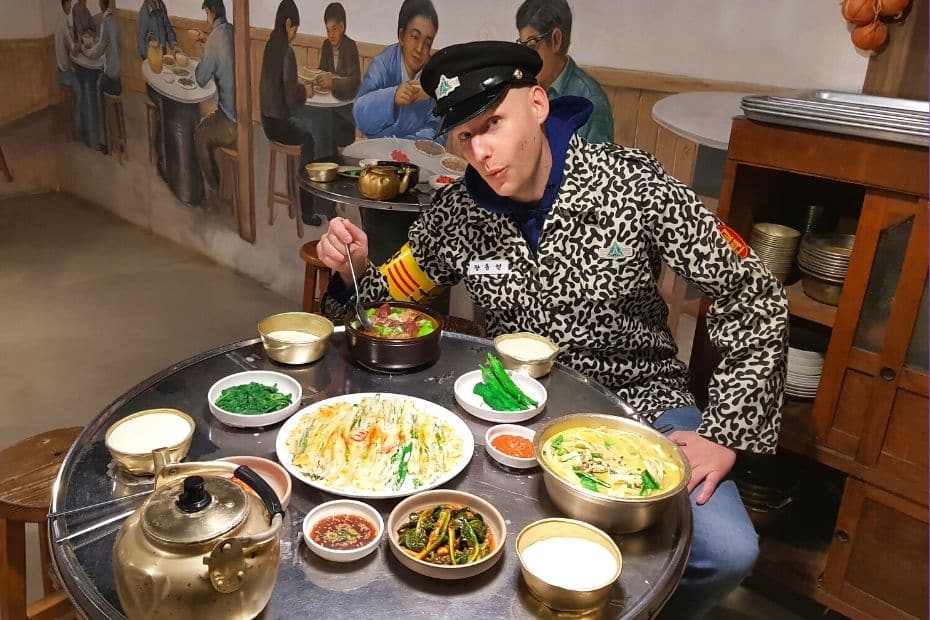
I’ve lived in Korea since 2015 and instantly fell in love with the food. There are so many unique culinary experiences – from the large group meals to the snack-able delights you can find in small street stalls or mountaintop shacks.
I’ve tried everything on this list and a lot more. So, what are my 3 favourite traditional dishes?
Well, I have to put samgyeopsal on the list – it’s a dish I enjoy regularly with friends. And one that I probably eat too much of for my own good!
Next up is my go-to lunch snack or can’t-be-bothered-to-cook-dinner meal – gimbap. This small, but filling, dish is great for lunch or dinner and you can eat it with dumplings, ramyeon, tteokbokki, and other foods.
Finally, a relatively plain dish compared to some of the others available, one that’s really just a bowl of noodles – kalguksu. I fell in love with this dish near my old workplace and eat it a lot during winter.
Kalguksu is really filling and perfect when it’s cold as the soup is hearty and warming. The noodles are thick and chewy and you can eat a big bowl of this without feeling too guilty as it’s not unhealthy.
How about you? What are your favourite traditional Korean dishes? Please let me know in the comments.
Liked This? Pin It For Others
If you enjoyed reading this article, then please share this with your friends on Pinterest.

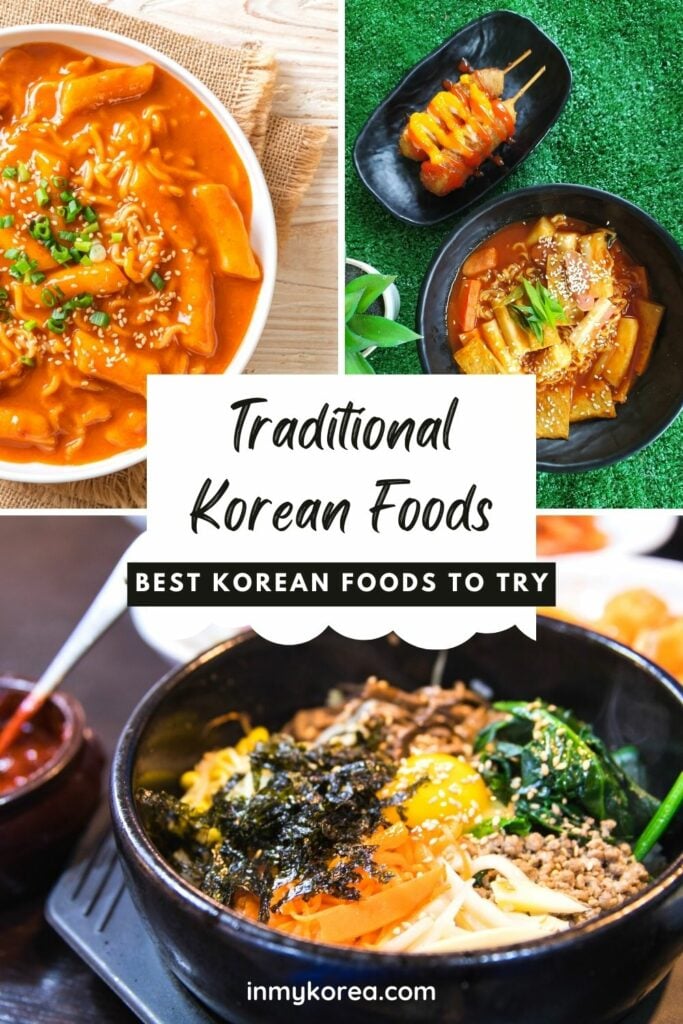
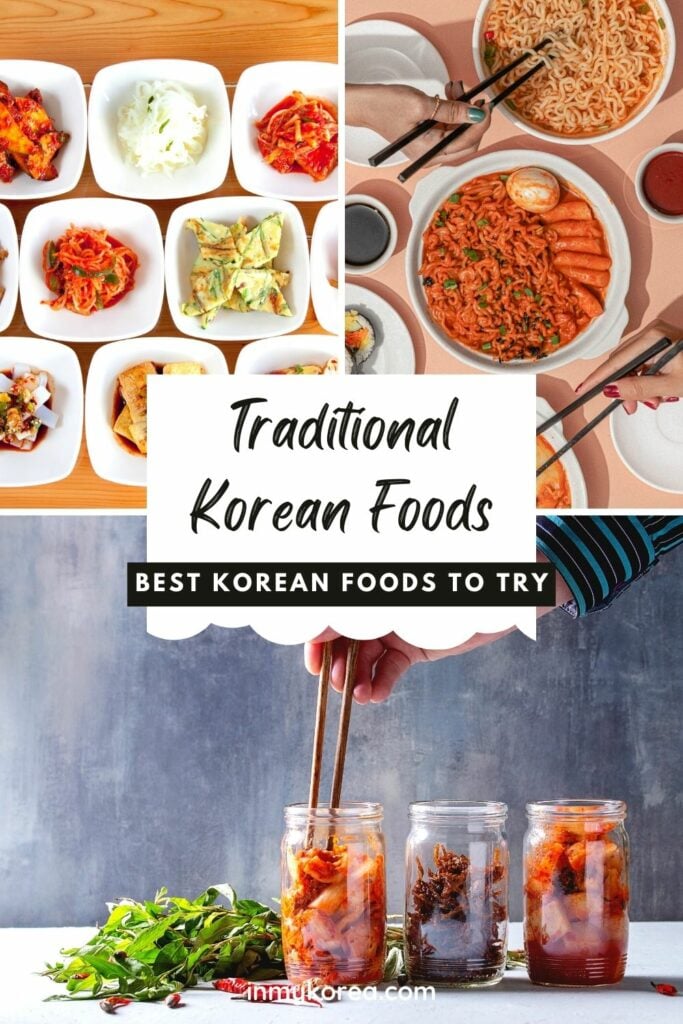
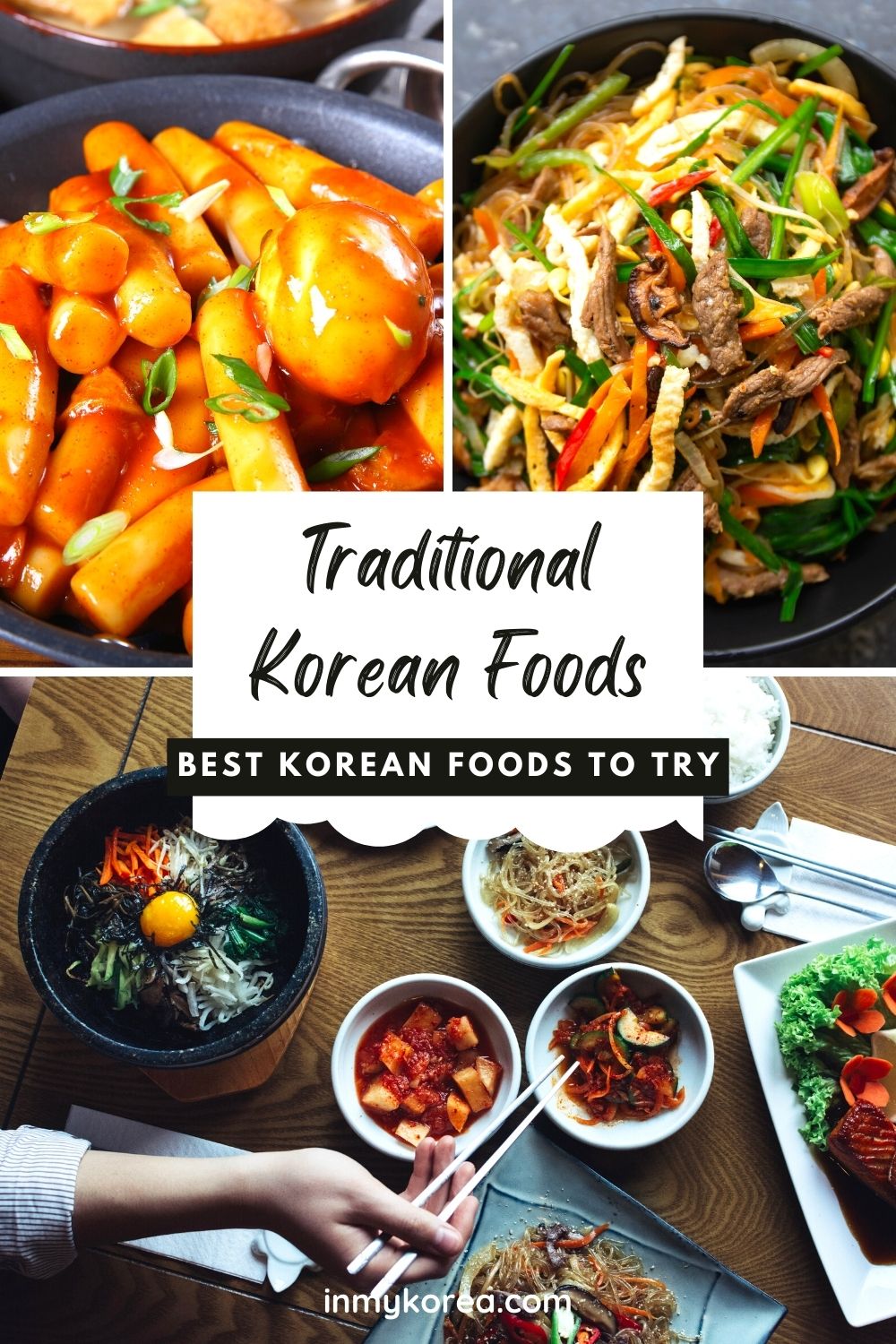
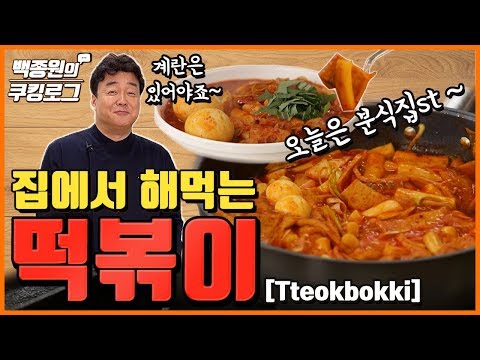


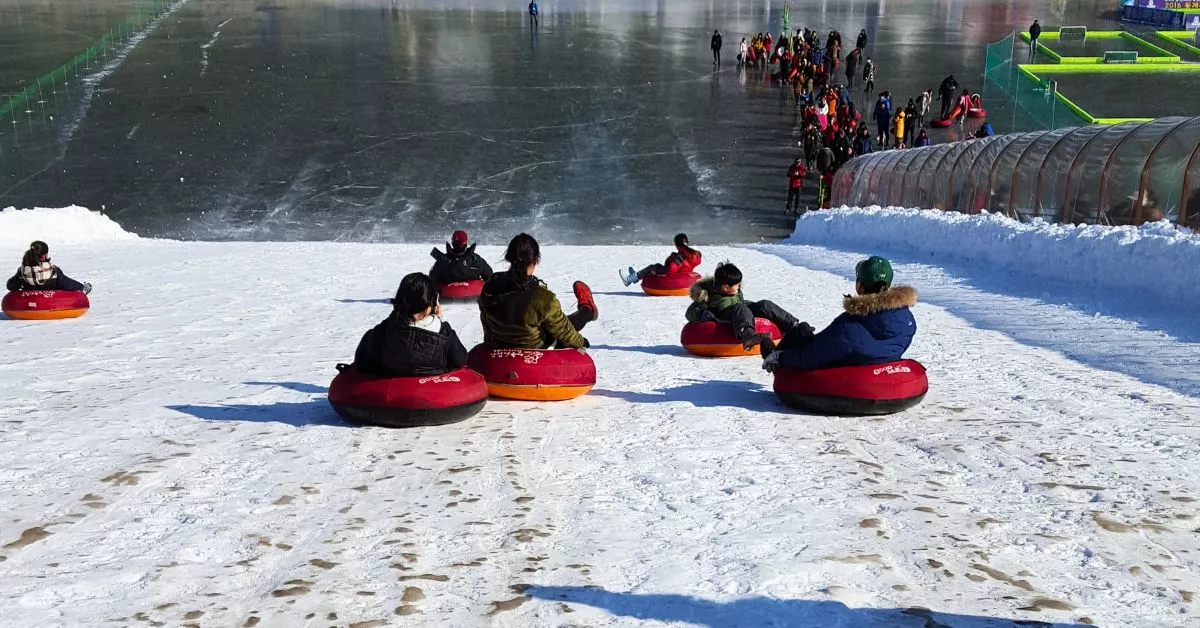

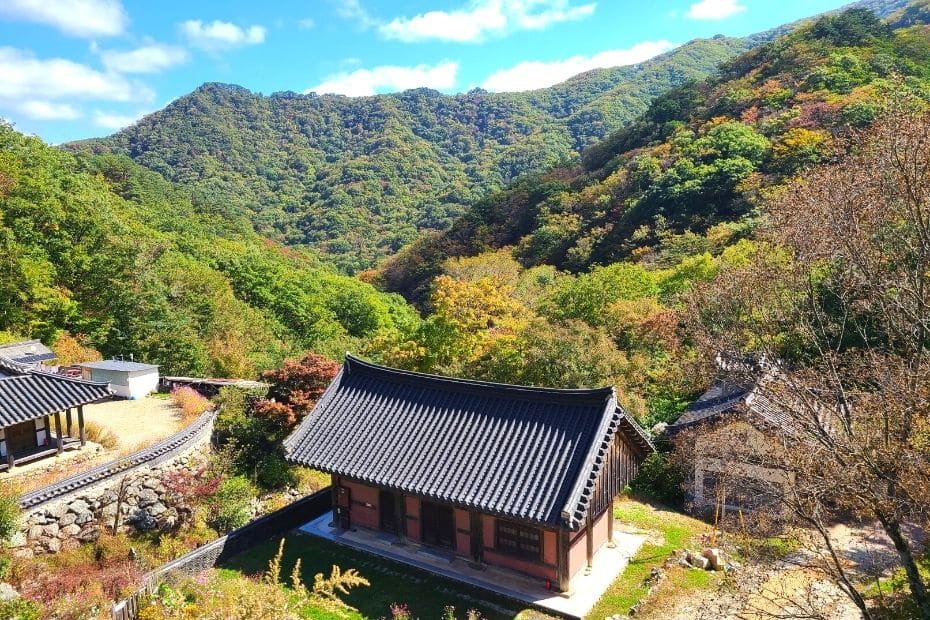

The Korean nutrition is absolutely scrumptious and
I’m grateful for it!
I was stationed in the Army at Camp Humphreys from 1971-72 and like you, I love the Korean food! As you said, they don’t skimp on how much you get for your money and I can’t remember ever trying anything I didn’t like. Hopefully you will send me more recipes I can print off as I’m very much into cooking Korean food.
Tim
Thanks for reading, hope you could taste the food through the pictures if you can’t get the real thing where you are now. Definitely good value for the price, even these days. Thanks for the idea, I might try to find some recipes to add for this article so people can try them at home.
Your website is wonderful. I want to learn more about Korean Food etc. Please sign me up to receive emails from your company.
Hi Stephen, thank you for reading our post and kind words. Unfortunately we don’t currently have an email list, we’ll get to it soon, and will definitely add you when that is ready.